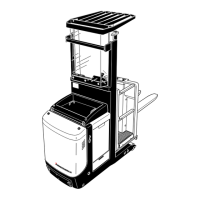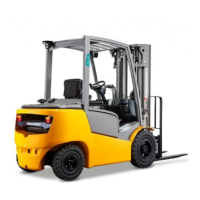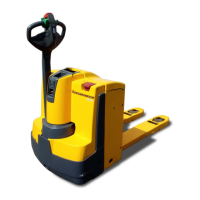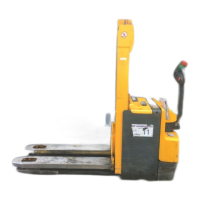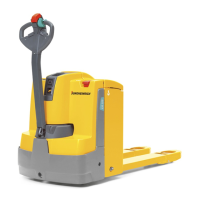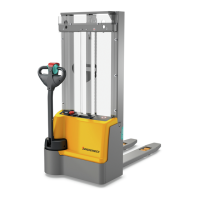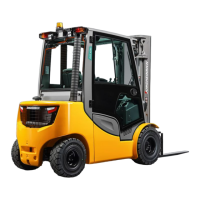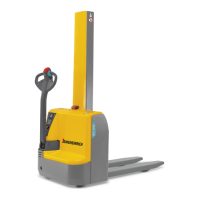D 1
1298.GB
D Battery - servicing, recharging, replacing
1 Safety regulations governing the handling of lead-acid batteries
The truck must be parked and rendered safe before any operations on batteries are
to be undertaken (refer to chapter E).
Servicing staff: Recharging, servicing and replacing of batteries must only be per-
formed by qualified personnel. The instructions contained in this operating manual,
and the instructions as prepared by the battery supplier and as available at the battery
recharging station must be observed, when performing the above operations.
Fire protection measures: Smoking and naked flames are not permitted when
handling batteries. No inflammable substances or spark-generating materials must
be present or stored within a distance of 2 meters of the truck parked for battery re-
charging. The location must be well ventilated. Fire fighting equipment must be kept
ready.
Servicing of batteries: The battery cell screw caps must be kept dry and clean. Ter-
minals and cable shoes must be clean, lightly greased with pole grease and must be
securely tightened.
Disposal of the battery: Batteries must only be disposed of as stipulated in the na-
tional environmental protection regulations or waste disposal provisions. The manu-
facturer’s specifications for the disposal must be heeded.
m
Before closing the battery hood, make sure that the battery cable cannot be dama-
ged.
f
Batteries contain dissolved acid, which is toxic and caustic. For this reason protective
clothing and goggles must be worn whenever work is undertaken on batteries. Avoid
physical contact with battery acid. If clothing, skin or eyes have accidentally come into
contact with battery acid, liberally flush the affected parts with clean water. Consult a
doctor, when skin or eyes have come into contact with battery acid. Spilled battery
acid must be immediately neutralised.
2 Battery types
Depending on their application, the WK truck is equipped different with battery types.
All battery types are approved according to DIN 43531-A. The following table shows
the standard battery combinations and battery capacities:
The battery weights can be seen from the battery identification plates.
f
Battery weight and dimensions have a considerable influence on the stability of the
truck. Therefore, a change of the battery type is only permitted with the prior consent
of the truck manufacturer.
Battery type Truck type
48V 560 AH KMS 100
48V 600 AH KMS 100
D 1
1298.GB
D Battery - servicing, recharging, replacing
1 Safety regulations governing the handling of lead-acid batteries
The truck must be parked and rendered safe before any operations on batteries are
to be undertaken (refer to chapter E).
Servicing staff: Recharging, servicing and replacing of batteries must only be per-
formed by qualified personnel. The instructions contained in this operating manual,
and the instructions as prepared by the battery supplier and as available at the battery
recharging station must be observed, when performing the above operations.
Fire protection measures: Smoking and naked flames are not permitted when
handling batteries. No inflammable substances or spark-generating materials must
be present or stored within a distance of 2 meters of the truck parked for battery re-
charging. The location must be well ventilated. Fire fighting equipment must be kept
ready.
Servicing of batteries: The battery cell screw caps must be kept dry and clean. Ter-
minals and cable shoes must be clean, lightly greased with pole grease and must be
securely tightened.
Disposal of the battery: Batteries must only be disposed of as stipulated in the na-
tional environmental protection regulations or waste disposal provisions. The manu-
facturer’s specifications for the disposal must be heeded.
m
Before closing the battery hood, make sure that the battery cable cannot be dama-
ged.
f
Batteries contain dissolved acid, which is toxic and caustic. For this reason protective
clothing and goggles must be worn whenever work is undertaken on batteries. Avoid
physical contact with battery acid. If clothing, skin or eyes have accidentally come into
contact with battery acid, liberally flush the affected parts with clean water. Consult a
doctor, when skin or eyes have come into contact with battery acid. Spilled battery
acid must be immediately neutralised.
2 Battery types
Depending on their application, the WK truck is equipped different with battery types.
All battery types are approved according to DIN 43531-A. The following table shows
the standard battery combinations and battery capacities:
The battery weights can be seen from the battery identification plates.
f
Battery weight and dimensions have a considerable influence on the stability of the
truck. Therefore, a change of the battery type is only permitted with the prior consent
of the truck manufacturer.
Battery type Truck type
48V 560 AH KMS 100
48V 600 AH KMS 100

